by Mike Melendez | Feb 14, 2018 | Weekly Player Profile
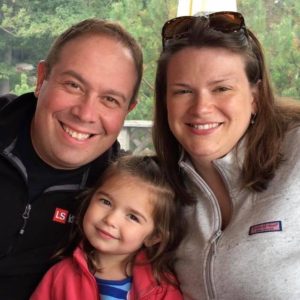
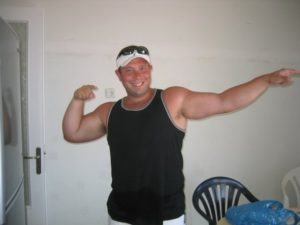
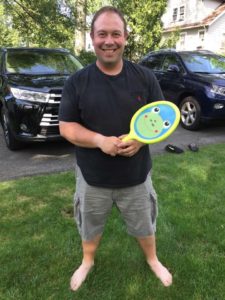
Jimmy Kandylas Paddleball Profile by Dave Siegel
When I write my paddleball profiles, a list of questions is sent to the subject that elicits some basic information. Then I usually reach out via interview, hoping to draw some interesting tidbits. Well, for Jimmy Kandylas we got literally an autobiography, a 51/2 page, 9.5-point font, single-spaced document. This was actually not a surprise, considering the length of some of his postings in the Facebook PFA group. I told Mike, let’s just publish it as-is. Mike said, “No way! We’ll do it like all the others.” Yes Sir, here goes:
Actually, the length and content of Jimmy’s “autobiography” is an indicator of how seriously he takes the game and the true lover of paddleball that he is. He has given a great deal of thought to what makes the game tick and what needs to be done to keep it growing. The one thing he did not mention, however, is his benevolence to the sport. He is one of the greatest contributors to the game, both in terms of financial assistance and dedication of his own time and effort. Jimmy is an attorney and was instrumental in making the PFA a legitimate non-profit organization. He has also provided pro-bono legal assistance to Mike on numerous occasions. Plus, not only for the PFA, but for other organizations as well, he has made cash donations, provided food for tournaments, shirts for kids and helped out at tournaments.
Jimmy has been playing paddleball for 25 years, with a 7-8 year layoff, having resumed regular playing in 2017. His paddleball history starts and continues to this day at Bay 8th Street. As a child, his Dad, a paddleball player himself, took him to the park and by the time he was 16, he was playing seriously. Jimmy reflects now that having his parents close by was actually a negative in the development of his game because of the pressure he felt to impress them. Bay 8th Park shines through as the focal point in Jimmy’s paddleball life. It’s where he learned the game, hung out and made great friends. Even though he has lived in New Jersey for some time, he still comes back to play once or twice a week to what he calls the “Mecca” of big-ball paddleball.
Jimmy is a big guy with a strong offensive game, always on the attack, and has deceptive quickness. Refreshingly, he is quite self-deprecating in assessing his game. He considers power to be his greatest asset, almost to a fault. He says he often tries to just blast it when he is in trouble, but “unfortunately that doesn’t work too well against better competition.” He is a right handed, primarily right side player and his favorite shot is the spike to the right corner, which he says if the opportunity is there, “I’m taking it!” He regrets that if he doesn’t hit it quite right, he usually “eats it,” especially when playing against people familiar with his game. Jimmy has a long list of Bay 8th Streeters and other paddleball players from whom he has benefited from playing with and watching. Among them, Bobby Fiorentino, Bay Liu, Vito DiSpigna, Jimmy Hoe, Anthony Russo, Gene Grilli, Glen Winokur, Keith Jackson, Mike Dembin, Mitch Goldberg, Paul Angel and Dave Blatt.
While many people in the paddleball community have expressed pessimism on the future of the game, Jimmy optimistically sees its resurgence. He cites the invasion of top young players, including Danny Fraschilla, Megan Flash, Julio Blanco, Mike Bergida, Joey Liota, Brian Romero, Ryan Lopez, Melissa Sky and Dave Blatt. He looks at the paddleball calendar and sees the summer months filled every weekend with a tournament, a PowPow or other organized get-together. But of course he knows there must be a concerted effort to have the sport grow and has some solid theories on how to best accomplish it. First, we need to balance the emphasis on competition via sponsored money-prize tournaments versus the recreational aspect of the game, making the game as much fun as it possibly can be. “I think balancing competition with community is the surefire path to success.” Also, he believes that there is a wealth of people in other sports to draw from: persons playing similar sports like handball, racquetball and tennis, as well as athletes who are “aging out” of their organized competitive sports like baseball, hockey and football. He sees pickleball as a model of how to accomplish this in that its leaders have done a great job of converting players from other sports.
What about Jimmy’s life outside of his paddleball world? Go to his Facebook page and read it for five minutes and you know what is Number One: Family. He posts incessantly about his beautiful four-year old daughter Kalli, with wonderful anecdotes and photos. The story of her telling him that she wants to have a baby is priceless. He was actually motivated to learn to cook for Kalli and has become quite accomplished, including his favorite: orange flavored French toast on Challah bread. Ironically, she won’t touch it, opting instead for her Cheerios! Jimmy is also a former powerlifter; he is into science fiction and super heroes and “any other geeky thing you can imagine.” And, he is a pizza lover. “I could eat pizza all day, every day.”
Back to paddleball, Jimmy recognizes that one of the problems that the ongoing effort to grow the sport needs to overcome is getting people on the same page in moving ahead and not criticizing those who are innovating or putting forward new ideas. His message is that we are all on this boat together and it is a small boat. We should all work together and pull in the same direction. “We have so many great people involved… if we were able to just keep focusing on having fun days and growing the paddleball community in a positive direction, the sport will do really well in the near future.”
Jimmy is grateful that his paddleball community has been good to him. He loves that when he came back to the game last year, he was welcomed like he never left. Plus, he has made lots of new friends and “that means the world to me. Thank you all!” Jimmy, the paddleball community thanks you too! Now, next time please keep it down to a couple of pages (double spaced, 12-point font)!
by Mike Melendez | Feb 3, 2018 | Legend of the Game, Weekly Player Profile

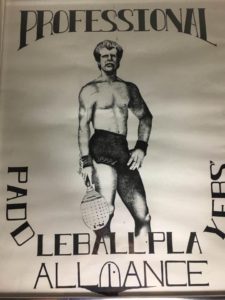
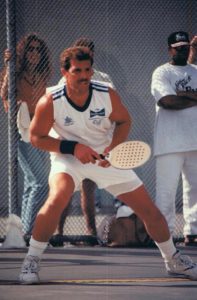
Donnie Ciaffone Paddleball Profile by Mike Melendez
The decade of the 1980s marked the Golden Years of paddleball as the sport’s popularity skyrocketed across the five boroughs of New York. Many of the public parks were producing budding stars. At Bay 8th Street in Brooklyn a 16 year old kid named Donnie Ciaffone was attracting much attention and the word spread across the city. Donnie was gifted with superior athletic talent, chevalier social skills, and a unique, almost “rock star” presence. Yes! At Bay 8th Street the sport of paddleball was shaping its next star!
Donnie was born in Brooklyn and started playing paddleball at the age of 15 at a small park on Avenue S in Bensonhurst. Eventually he was looking for tougher competition and took his game to Bay 8th, which became his home park. Donnie recalls, “While coming up in the sport at Bay 8th a great legend named Caesar Polichetti took me under his wing and taught me discipline, technique and how to use my left hand. I then met another legend, Rochelle Weiner Martinez, who introduced me to the games played across the city.” Donnie became one of the best players at Bay 8th, his deadly game dominated by extraordinary power and incredible spikes. The spike was his favorite shot, which he hit to all angles of the court, but yet his game was guided by a smooth, graceful glide. He made the game look so easy.
Donnie took on all comers at Bay 8th for 15 years, while competing in tournaments across the tri-state area. Donnie and Rochelle teamed up for many tournaments and won several championships, including two Budweiser mixed doubles. Mixed doubles was closest to his heart and he loved playing with Rochelle and at times they were unstoppable. Donnie was also an early proponent of women’s equality in paddleball. Ray Gaston, the president of the Professional Paddleball Players Association, the organization of paddleball’s Glory Days, said, “Ciaffone was one of the first paddleball super-stars to actively lobby for greater women’s participation in the sport. In an era when women players were not taken as seriously as they are today, Donnie often challenged other male greats to play more mixed doubles. “Let’s hear it for the ladies!” was his cry. This stance, coupled with his dashing stature, earned him icon status and his image was incorporated into the PPPA logo.” Paddleball legend, Anita Maldonado said, “There are real marriages and then there are mixed doubles marriages in paddleball. One of those special unions was Donnie Ciaffone and Rochelle in the 1980s. They dominated one-wall mixed doubles like no other team. What makes a great mixed doubles team? The most important ingredient is an awesome player like Donnie Ciaffone. He was athletic, smart and he was hard hitter. He always fought for position and used his partner as a pick. His height enabled him to have the best spike in the game. When Donnie spiked the ball, he spiked it out of the park! He was tall, blonde and boy was he handsome! Although he was not as dominant in men’s doubles as he was in mixed, Donnie will go down as one of the best players of the 1980s!”
At the age of thirty, Donnie moved to the Bronx where his game matured as he faced fierce competition. Donnie recalls, “In the Bronx I was spanked and taught by players like Anthony Fiorino, Robert Cheilli, Ralph Capogrosso, Craig Ruiz, Bobby Fiorentino, Fernando Frias and Mike Melendez.” Speaking for myself, I teamed up with Donnie for a number of years and I can personally say he was humble and gentle by nature, but everyone knew when Donnie was in the park! Whether at an elite private beach club against other top ranked players or in a local urban tough neighborhood park against lower-level ranked players, it didn’t matter, the man was there to play!
Present day, Donnie lives in Florida and plays about twice a month at Hollywood Park. He would like to play more, but like many of us, the game he played for so many years has resulted in his body taking a beating, and it has taken its toll. “After spinal surgery, and having both knees replaced, my paddleball game just isn’t what it used to be.” He has taken up pickleball, which is the sport he now mostly plays because it’s much easier on his body.
On the personal side, Donnie has this to say about his life today: “I live with my wonderful, beautiful wife Neda. She is my world. I love to play pickleball and I love to fish. Living in Florida makes this very accessible to me. As far as food goes, I’m a meat and potatoes guy and I love an occasional martini. Most of us think that it’s all about winning, but it’s not. The friendships, the physical exercise and family union are what’s most important.”
How does Donnie feel about the paddleball game today? “I think paddleball has grown in diversity with the different balls that are presently played. I love the fact that there are now young players in the game and what the Paddleball Family Alliance is doing with the clinics is remarkable. Thank you Mike for that. My advice to young players is to pace yourself and to play only when you’re healthy. I have seen what can happen first-hand by overplaying. I believe paddleball is on the right track and I wish it would spread nationally.”
“When we consider One Wall “Legends,” few in paddleball come larger than Donnie Ciaffone!” – Ray Gaston
by Mike Melendez | Jan 23, 2018 | Weekly Player Profile

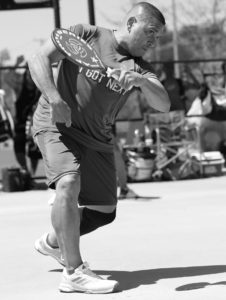
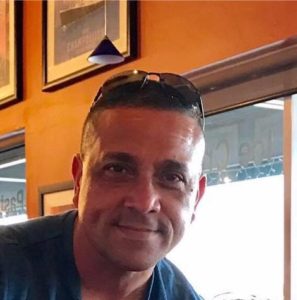
Ray Sanchez Paddleball Profile by Dave Siegel
What does ADS stand for? I tried Googling it and found American Daffodil Society, All Day Sickness, After Dinner Speech, All Directional Shower and Automatic Dice Server. Actually there are over 100 listed, but nowhere to be found is “Ace Drop Shot.” Ray Sanchez claims this as his shot and coined the ADS acronym as a tribute to the shot’s greatness, and he even uses ADS as his moniker. I haven’t had the opportunity to see Ray play much, but Mike Melendez told me he’s never actually seen him successfully execute a drop shot (LOL)! How could that be, Mike? It’s his name! Well, Ray and Mike will have to settle this. Anyway, this is all part of Ray’s persona as the life of the paddleball party. He keeps everyone loose with his joking and clowning, while being a great friend to the paddleball community.
But Ray is more than a comedian at the courts, he is also very good player. He rates himself as a B to B plus player. He is a solid, tough competing lefty with power, quickness, a very effective serve and outstanding anticipation and positioning. His favorite shot is to the corner on either side. He plays both small and big ball and works hard at improving his game as he strives to advance in the ratings.
He learned the game hanging out at Zerega Indoor and watching some of the top players of the 80s, among them, Robert Sostre, Sammy Cesario, Frank Savino and Anthony Fiorino. He watched them in awe and when he was finally able to get on the court with them, “Wow! the rest is history!” In recent years, Nelson Deida, Andre Hopkins and Mike Melendez have been major influences. The Hop taught him to have a plan on every serve and Ray’s exposure to Mike’s overall “awesome game” has helped him advance as a player.
Ray has been playing for thirty years with a few gaps in between. He started in Van Cortlandt Park and still considers it his paddleball home. He also plays regularly at Zerega, Juniper Park and at the HES in Brooklyn. Ray is dedicated to the game and presently plays two to three times per week. He says, “I love the intensity and competitiveness of the game.”
Ray’s big contribution to paddleball goes well beyond his playing and the comedic relief he provides. He is a big supporter of the paddleball revival movement and in particular, the Paddleball Family Alliance and its mission of teaching the youth, upholding the rules of conduct, promoting respect among players and improving the refereeing through training. He continuously promotes tournaments and events, oftentimes with a touch of his brand of comedy. He has volunteered on many occasions at Mike’s kids clinics and has made several cash donations to support the cause. In his real life, he is involved in artwork and printing and helps Mike with the design of the promotional material, including the tee shirts, posters, etc.
Ray gave us a scare last summer at a tournament in Juniper Park. He became dehydrated and needed emergency medical treatment. Ray says he is fully recovered and is confident that the changes he has made to his fluid intake will prevent recurrences. He cautions the paddleball community to stay hydrated, especially in the hot weather.
What about Ray’s non-paddleball life? Ray has two sons, a daughter and two grandchildren. His livelihood focuses on print coordination, specializing in creative software and he is a master printer. He is a hard worker, always willing to try new things. Ray reveals that he has a secret talent: he does a mean imitation of Yoda from Star Wars (voice only!). His sports hero is Joe Montana and his favorite type of food is Mexican. Not surprisingly, he is very conscious of the needy, and has recently developed a soft spot in his heart for helping the homeless, as he is now getting involved in this great cause.
Ray’s message to the paddleball community: “I love playing paddleball. It is an excellent pastime of fun, a good workout and I am fond of the friends I have made along the way.” Ray, there is no doubt you have fun in the game! Now we just need to get the internet up to speed and recognize ADS!
by Mike Melendez | Jan 18, 2018 | Weekly Player Profile

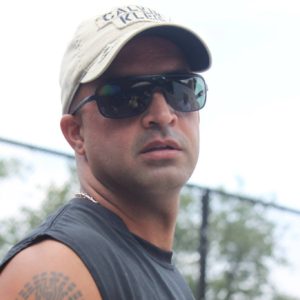
Carlito Espinal Paddleball Profile by Mike Melendez
Carlito’s Way
He is quiet and most of the time he wears a friendly smile on his face, but don’t let that fool you. On the court, he has the killer instinct of a lion. Carlito has proven himself to be one of the top players in the game today, with a vast arsenal of shots at his disposal. He can play a mean game of both small and big blue paddleball, as well as racquetball. When his game is “on,” he is a BEAST, hitting winners from any angle within the playing area of the court – “Carlito’s Way!”
Carlos Espinal was born in Brooklyn and has been playing paddleball since the age of eight. He started at the “6’s” park (also known as Bush Park) in Queens. His brother Ralph was his biggest influence and is the reason he started playing. Early on, Carlito frequently went to the park to watch his brother play and he quickly developed a love for paddleball. He watched many great players from whom he learned the game, including Gary Evans, Milton Pérez, José Guadalupe and Richie Miller. Later on, he gained much knowledge from Anthony Fiorino, Sammy Cesario, Robert Sostre, Donnie Ciaffone, Ramon “Papo” Padilla and lefty Ralph Badillo. But his brother, Ralph, who was a solid player himself, was always his paddleball role model. Eventually paddleball at the 6’s park ended and he and his friends moved on to Flushing Meadows, which became his home park. By the time he was fourteen, his game was strong enough to compete with the top players at Flushing, including Farley Figueroa, Miguel Mateo, Kevin Rolon and Godfrey Brown. At approximately age eighteen, another passion took over his sports life. He had become involved in playing baseball and softball, which conflicted with his weekend paddleball time, and his interest in paddleball waned.
After a 10 year hiatus from the sport, he returned to paddleball because he missed it and he wasn’t playing as much baseball/softball. During the summer, he split his playing time between Orchard beach in the Bronx and Juniper Park in Queens. In the winter season, he played at McFadden’s, Astoria Indoor and, of course, Zerega, the mecca of indoor paddleball, which eventually became his home court. There, he battles with some of the top players in the game.
Carlito’s game is power and he is one of the hardest hitters in the game today. He keeps his opponents on defense and overwhelms them with his drives. Carlito loves powering the serve low or high and then attacking the wall off his opponent’s return. His favorite shot is the spike or “Yonker.” He also has excellent control, is very physically fit and has one of the best cut/slices of the present day players. He said he learned this shot from Freddy “The Animal” Diaz, who was also his favorite player growing up and had “every shot in the book.”
Carlito loves the sport because of its competitiveness, power and speed. He has won his share of tournaments, but presently he is not enthusiastic about playing in tournaments because of all the bickering that goes on. He is pleased that the PFA and other tournament directors are working to fix this condition, but for now he’d rather get a group of players and “go beat each other up for a few hours.” He likes to play both small and big ball equally, as both games have their own challenges, which he very much enjoys. He also loves the great family atmosphere. He said, “Everyone in the paddleball community has been around for years and it is like family.”
On the personal side, his sport hero is Michael Jordan, “He had that killer instinct and knew how to execute.” His favorite food is a nice medium-rare rib-eye steak. He loves sports in general and has played handball, tennis, football, basketball, softball, baseball and table tennis.
What about the future of the paddleball game? He believes that for the game to grow, more exposure, sportsmanship and sponsorship is needed. “We need people with passion to push for those sponsors. People like Kathy Guinan, Mike Melendez and the others involved in the PFA.” Thank you Carlito! As far as changes in the sport, he would like to see independent, non-playing referees in tournament competition. “That would eliminate some of what, in my opinion, is the favoritism that exists to some degree.” His advice to his peers is “to play, compete, but also have fun doing it.” He said that for many years he played to win and didn’t always enjoy the game as much as he could have. “When you only play to win you forget how to have fun.” Carlito’s Way!
#PaddleballGotNext!
by Mike Melendez | Jan 8, 2018 | Weekly Player Profile
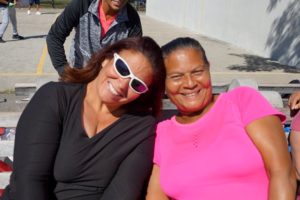
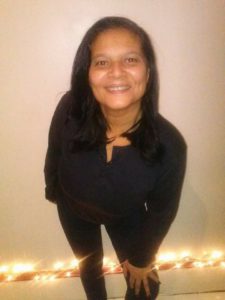
Miriam Silva Paddleball Player Profile by Mike Melendez
Although she has been playing big blue paddleball for only a year and a half, Miriam Silva has quickly climbed to the top of the women’s division and is a force to be reckoned with in the coming years! It’s remarkable that in this short amount of time she has already won six tournaments!
Miriam is an aggressive right handed player with that never-give-up determination. Her game is structured around taking immediate control of rallies with her powerful and consistent serve, her return of serve, as well as her forceful forehand and backhand strokes. In fact, Miriam’s forehand is considered to be one of the most powerful in the women’s game. She has all the shots in her arsenal – she can spike it, drop it, but by far, her power drive is her money shot. She can jam most of her opponents as very few women are capable of. Miriam is also deceptively quick on the court and has very good anticipation.
Like many paddleball players, Miriam started out playing handball and plays at a very high level – she is a certified ‘A’ player. She also is an excellent one-wall racquetball player. Miriam fell in love with paddleball after watching her dear friend Jewel Pacheco engaging in an intense doubles paddleball match at Central Park. It was with Jewel’s encouragement that she tried paddleball. From the outset, she realized that her aggressive style enabled her to make a perfect transition from racquetball and handball to paddleball. She said, “At present, I am passionate towards paddleball, as it strongly resembles handball, my original sport of choice.” During the winter months, she plays mostly weekends and in the summer, she plays as much as possible traveling to different parks looking for tough competition. Her paddleball home is Central Park.
On the personal side Miriam is a loving mother and grandmother. She LOVES to spend time with her sixteen year old son Jacob, who was diagnosed with autism. It is because of him that her passion shines through in her game. She is a talented lady, who can also crochet, is a great cook, and takes pride in being a wonderful mother and grandmother. Her favorite food is her daughter Jessica’s pasta and meat sauce.
Back to paddleball, she strongly feels that for the sport to grow, players must display good sportsmanship on the court. I asked her what she would like to change about the sport. She thinks increasing exposure is key for it to rise to the next level. Though she does not favor a specific paddleball player, she tries to emulate the style of the great superstar tennis player, Rafael Nadal, who is also her sports hero. She does have a peeve concerning paddleball: “Though there are paddles featured with the names of male competitors, there are no featured paddles with any FEMALE players on any of the signature brands. This, despite the fact that there are so many female players in the game today.” I could not agree more with you, Miriam! Paddleball manufacturers, the time has come to give the women players the recognition they have surely earned! They are one of the reasons the sport is on the rise! #MiriamAndTheLadiesGotNext!
by Mike Melendez | Jan 5, 2018 | Legend of the Game, Weekly Player Profile

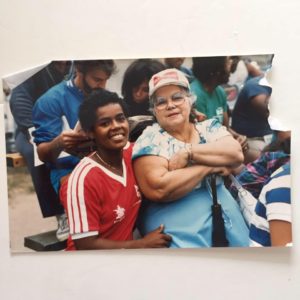

Anita Maldonado Paddleball Player Profile by Dave Siegel
The magnificent award-winning profile photo says it all. We see the acrobatic athletic ability, her skill, and most importantly, the never-give-up determination. And yes, Anita Maldonado made the shot! And it was a killer!
The 1980s was the golden age of paddleball, with an estimated 440,000 men, women and children of all ages playing this urban New York City game. There were many excellent players, but far and away, the most accomplished woman player was Anita Maldonado and she might very well go down in history as the best woman paddleball player ever. Anita won an incredible eight out of nine Budweiser women’s singles titles from 1981-89. In 1992 she played in her last singles tournament, again winning the Bud Classic and it was in the finals that Anita made the fantastic, historic, diving shot.
Like many paddleball players, Anita started out playing handball. For her it was at the local courts at 108th St. and Park Ave. in Spanish Harlem, where she grew up. She says that the instant she first picked up a paddle, she was attracted to the sport and soon was playing every day. Eventually Anita moved to Central Park, followed by the Yankee Stadium courts and finally she settled in at Carmine Street, where she played for many years as her home park.
Anita did not become great by just playing the game and having fun. She put in long hard hours practicing, training, and working on her endurance. With her intelligence and mental toughness, combined with hard work, she knew that she could rise to the top in paddleball, and indeed she did. One person who played a very significant role in Anita’s paddleball career was Aubrey Nelson. Aubrey, who Anita described as a “paddleball intellectual,” and “like a father to me,” was her coach and mentor throughout her tournament days. He imparted great wisdom and helped transform her into a complete player, featuring stamina, quickness and power. Another person who had a tremendous inspirational effect on her life was her late mother, who was her number one fan and attended all of her tournaments.
Anita’s game was highlighted by power, combined with smarts. She could spike it and could jam her opponent as very few women were capable of. Why did Anita gravitate to singles? She now says that striving to excel in singles truly drives a player to become dedicated to working out, staying in shape, learning the game and playing it correctly. Anita says this commitment made her feel grounded. She feels doubles is a much easier game, not requiring the same level of preparation or physical fitness. She would like to see the present paddleball revival movement add singles to the tournament schedule, and indeed, the PFA is on the mark by hosting a successful tournament last September and planning to do others in 2018.
With Anita, it was not all about her. As she became more accomplished, she gave back to paddleball, becoming an inspiration and mentor to many players. During her championship years, Anita and Mike Melendez teamed up with Budweiser and the NYC Parks Department, conducting numerous, very successful clinics across the tri-state area that helped get even more people involved in the flourishing game of paddleball.
In the late 80s Anita sought to conquer a new sport, taking up racquetball. But this extraordinary athlete did not just dabble in the sport. As with paddleball, she gave it her all, and rose to the highest echelon. Anita competed in the Pan American Games and won medals in the Central American Games, including the gold in 1998, for which she is honored in a museum in Puerto Rico. She became a racquetball professional and was ranked in the women’s division as high as the number four player in the world!
Presently, Anita plays (and excels in) racquetball in all its forms: four, three and one wall. In the past year she has resumed playing paddleball and returned to tournament competition. She plans to continue in 2018. She notes a big shift to the big ball game, especially over the past year or two. Her mindset now is that she sees all these racquet/paddle sports melding together, and she will train for, and compete in any of them.
When Anita is not playing sports, she loves to watch tennis and basketball. Nadal and LeBron are her favorite players. She also cooks a mean yuca and eggplant with cod fish!

















Recent Comments